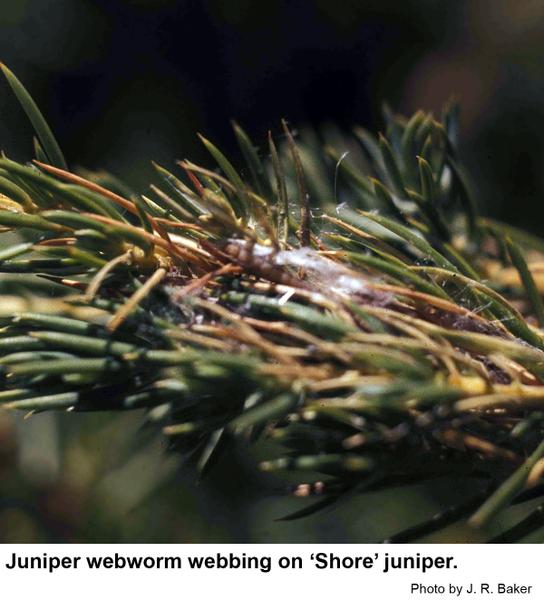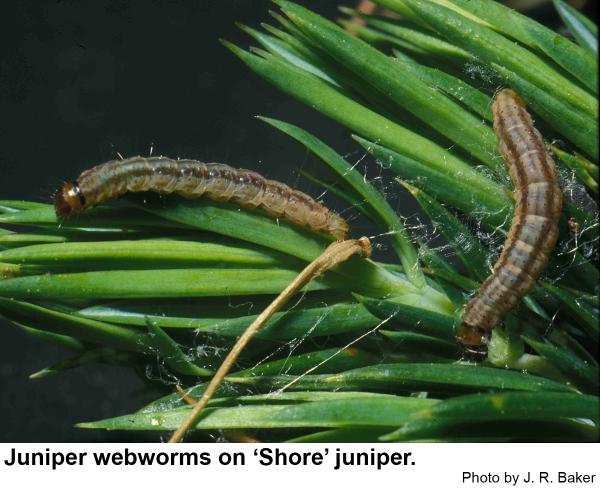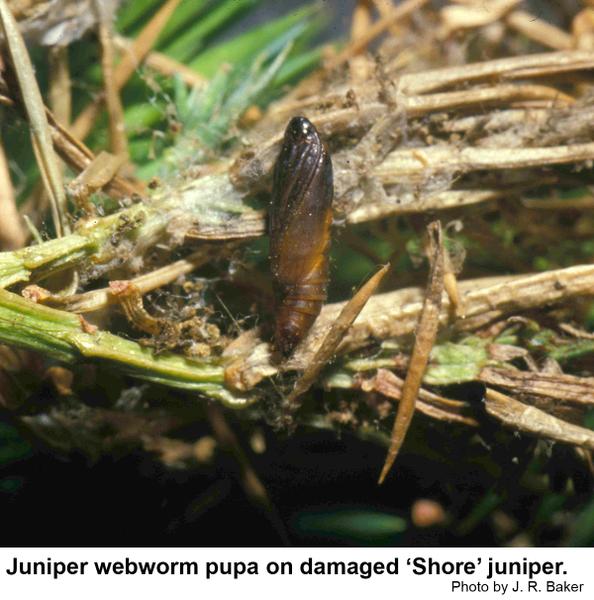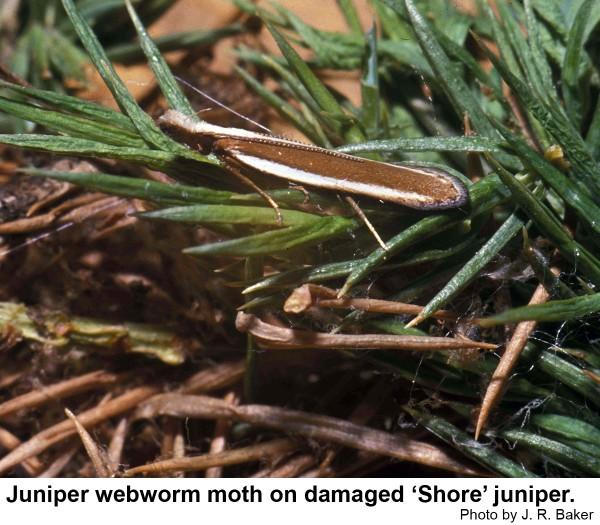General Information
The juniper webworm, Dichomeris marginella, was first reported on juniper in Europe in 1775. It also occurs in northern Asia and in the civilized parts of the United States. Adult juniper webworms are small, slender, brown moths (5⁄8 inch long) with white wing margins. They are rarely noticed as they fly only when disturbed. Female moths lay tiny white or pinkish eggs that darken with age. The juniper webworm caterpillar is small (3⁄4 inch long), whitish or light brown worm with noticeable reddish-brown stripes. Larger webworms are grayish brown with two dark stripes down the back with a fainter dark stripe in between. The pupa is light to dark reddish brown and is about 1⁄4 inch long.
Biology
Juniper webworms overwinter as partially to nearly grown worms inside webbed masses of juniper foliage. Shortly after pupating, adults emerge from May to July, peaking in June. Males live about 12 days; females about 14. After mating, females lay 50 to 200 eggs singly in the axil of new needles. About 10 days later, tiny larvae hatch, puncture the leaf and feed as leafminers, causing the leaves to brown. The mined leaf is used as a protective retreat from which the tiny worm emerges to feed on fresh foliage. A tiny, white web is formed around the infested leaf. As the worm grows, the web is expanded to encompass dead leaves. Silken tubes are then constructed in which the worms retreat when not feeding. The worms mature throughout the summer, fall, and winter. By the following spring, they feed gregariously and form a community web. Considerable amounts of foliage may be spun together, and small shrubs may be completely webbed. The worms pupate inside whitish silken cases, and new adults appear in about two weeks to continue the infestation. There is one generation per year.
Host Plants and Damage
The juniper webworm prefers Irish juniper, although Chinese juniper, red cedar and Juniperus communis cultivars 'aurea', 'horizontalis', 'depressa', 'hibernica', 'suecia', and 'squamata meyeri' are also infested. Juniperus procumbens and Juniperus squamata are infested only occasionally. Leaf mining by newly hatched larvae is inconsequential. Feeding and webbing by larger worms may seriously damage ornamental junipers as the webworms cause large masses of dead, webbed needles. Infested shrubs look unthrifty, and small shrubs may be completely webbed. Leaf mining by newly hatched larvae is inconsequential. Feeding by larger worms may seriously damage ornamental junipers.
Residential Recommendation
Braconid and ichneumonid wasps parasitize the larval and pupal stages of juniper webworms although their impact on the webworms is usually way too late to prevent significant damage. Juniper webworms are not particularly resistant to pesticides. Sevin or some other pesticide labeled for landscape use should give adequate control if applied when the webworms are actively feeding.
| Pesticide (Trade Name) | Formulation and Amount |
|---|---|
| acephate (Orthene) | 75% soluble powder: 1⁄3 to 2⁄3 pound per 100 gallons of water (homeowner formulations are available) |
| azadirachtin* (BioNeem, Margosan-O) | 0.3% emulsifiable concentrate: 21⁄2 to 5 teaspoons per gallon of water |
| azadirachtin (Azatin) | 3% emulsiable concentrate: 1⁄2 teaspoon per gallon of water |
| bifenthrin (Talstar) | 10% wettable powder: 1 to 1.5 teaspoons per gallon of water |
| carbaryl* (Sevin) | 50% wettable powder: 1 tablespoon per gallon of water |
| cyfluthrin (Decathlon, others*) | 20% wettable powder: 1⁄4 teaspoon per gallon of water (homeowner garden formulations are available) |
| fluvalinate (Mavrik) | 23% flowable: 1⁄6 to 1⁄3 teaspoon per gallon of water |
| pyrethrins* (Pyrenone, others) | 6% emulsifiable concentrate: 1⁄8 to 11⁄2 teaspoons per gallon of water |
| trichlorfon (Dylox, Proxol) | 40% emulsifiable concentrate: 2 to 3 pints per 100 gallons of water |
| * Suitable for home use. When used as directed, pyrethroids are very toxic to insects but are not particularly hazardous to humans and pets (other than fish—avoid using pyrethroids around pools, ponds, and streams). See the North Carolina Agricultural Chemicals Manual for other choices. |
|
Other Resources
- Insect and Related Pests of Shrubs. Baker, J. R. editor. 1980. NC Extension Service publication AG-189
- Juniper webworm. Malinoski, M. K., et al..1999 - 2000. HGIC - Landscape Problem Solver, Univ. Maryland Extension.
- Juniper Webworm. Schuster, J. No Date. Focus on Plant Problems. University of Illinois Extension.
- Nursery and Landscape - Juniper Webworm. Johnson, G. 2008. University of Delaware Cooperative Extension, Kent Co., Commercial Horticulture Information
- Extension Plant Pathology Publications and Factsheets
- Horticultural Science Publications
- North Carolina Agricultural Chemicals Manual
For assistance with a specific problem, contact your local N.C. Cooperative Extension Center.
Publication date: June 28, 2013
Reviewed/Revised: Sept. 25, 2019
Recommendations for the use of agricultural chemicals are included in this publication as a convenience to the reader. The use of brand names and any mention or listing of commercial products or services in this publication does not imply endorsement by NC State University or N.C. A&T State University nor discrimination against similar products or services not mentioned. Individuals who use agricultural chemicals are responsible for ensuring that the intended use complies with current regulations and conforms to the product label. Be sure to obtain current information about usage regulations and examine a current product label before applying any chemical. For assistance, contact your local N.C. Cooperative Extension county center.
N.C. Cooperative Extension prohibits discrimination and harassment regardless of age, color, disability, family and marital status, gender identity, national origin, political beliefs, race, religion, sex (including pregnancy), sexual orientation and veteran status.




